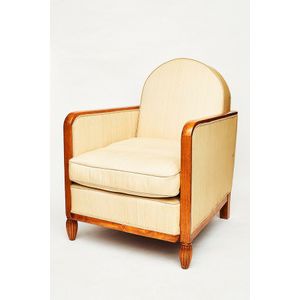Cream Upholstered French Art Deco Armchair
French Art Deco armchair, c. 1930, rounded back, seat and sides upholstered in a cream fabric, on two front fluted legs and two back square tapered legs, height 33.07 in., width 24.80 in., depth 27.56 in. provenance: Copeland & de Soos, Woollahra, c. 1980. Private collection, Sydney
You must be a subscriber, and be logged in to view price and dealer details.
Register Now to view actual auction price for this item.
- Art Deco Period - The Art Deco period was a cultural movement that emerged in the 1920s and 1930s, and was characterized by its emphasis on modernism, luxury, and elegance. The name "Art Deco" comes from the Exposition Internationale des Arts Décoratifs et Industriels Modernes, a large exhibition held in Paris in 1925 that showcased the latest trends in decorative arts.
Art Deco was a reaction against the ornate and elaborate styles of the previous era, and reflected a new modern sensibility. It was characterized by streamlined, geometric shapes, bright colours, and the use of new materials such as chrome, glass, and Bakelite. Art Deco designers sought to create a sense of luxury and sophistication, often incorporating expensive materials such as ivory, marble, and rare woods.
Art Deco had a significant impact on a wide range of artistic fields, including architecture, fashion, graphic design, and interior design. Some of the most iconic examples of Art Deco architecture include the Empire State Building in New York City, the Hoover Building in London, and the Palais de Chaillot in Paris.
The Art Deco period came to an end in the 1940s, as World War II and changing cultural trends led to a shift in artistic styles. However, Art Deco remains an important influence on design and art, and continues to be celebrated for its modernist sensibility and glamorous aesthetic. - Provenance - A term used to describe the provable history of an antique or work of art, and thus an additional aid to verifying its authenticity. Provenance can have an inflating effect on the price of an item, particularly if the provenance relates to the early settlement of Australia, a famous person, or royalty. Less significant are previous sales of the item through an auction house or dealer.
- Fluting - A form of decoration found on many pieces of furniture, as well as ceramics, silver and clocks, in which round-bottomed grooves, of varying width and depth, are let into columns, pilasters, legs. As a general rule, flutes are cut in the vertical, though they may follow a turned leg in a spiral pattern. In cross-section, they may be described as a series of 'U' shapes, rising and narrowing at each end of the groove. Fluting is the opposite of reeding, with which fluting is often associated.
- Tapered Legs - found on both cabinet and country-made furniture from the 18th to the later 19th centuries. The leg sometimes terminates in a spade foot, though on most country furniture the taper continues for the whole length of the leg. The important thing to remember is that the taper ought only to be on the inside face of the leg, and the outer face should be straight and square. Some legs were made where both sides tapered, but in such a case the taper ought to be the same on both the inner and outer faces of the leg. Where the inside of a leg is straight, with only the outer face tapering, there is every reason to be suspicious
This item has been included into following indexes:
-
chairs, singles / pairs / threes, style or period
- armchairs 1,769
- Art Deco style 70
- French 966
